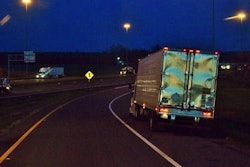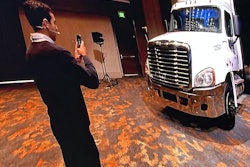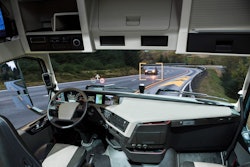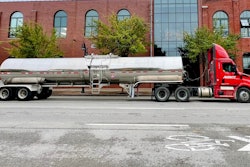U.S. Environmental Protection Agency (EPA) Administrator Lee Zeldin on Tuesday urged engine and equipment manufacturers to revise system software to prevent sudden loss of power from engine derates related to aftertreatment problems.
The proposal implements a tiered derate structure versus the current limp to 5 miles per hour, giving the driver more time and more power to get the truck to a safe location for repair.
 EPA on Tuesday issued guidance urging engine and equipment manufacturers to revise DEF system software in existing vehicles and equipment to prevent sudden engine derates, giving operators more time to repair faults without impacting productivity or safety. EPA
EPA on Tuesday issued guidance urging engine and equipment manufacturers to revise DEF system software in existing vehicles and equipment to prevent sudden engine derates, giving operators more time to repair faults without impacting productivity or safety. EPA
"Chances are that the truck is on the highway and it's got to be towed, and while it's sitting there it's a potential accident," said Darry Stuart, founder of truck maintenance consulting firm DWS Fleet Management Services. "I've done a couple of legal cases where trucks have been on the side of the road and cars come down and just whack 'em."
New rules for '27
Emission rules set for 2027 already called for manufacturers to provide more advance notice to operators during an aftertreatment system malfunction. EPA's guidance released Tuesday requires all new diesel on-road trucks starting in model year 2027 to be "engineered to avoid sudden and severe power loss after running out of DEF."
While the agency specifically references DEF in its announcement Tuesday, EPA confirmed to CCJ its new guidance "applies to any of a long list of potential 'fault codes' related to the DEF system, which on today’s trucks result in a 5 mph derate."
Additionally, the guidance states that vehicles already in use should undergo "the necessary software changes" to extend the timeline for engines derating due to DEF problems. By law, EPA cannot mandate field fixes for in-use vehicles, which is why the agency is issuing voluntary guidance to manufacturers on system modifications to reduce derates.
Mack and Volvo Trucks parent Volvo Group told CCJ Tuesday the company believes "the new strategy strikes the right balance between ensuring that potential system problems are addressed in a timely fashion and addressing customer concerns about the productivity impacts of the current inducements," and confirmed the software-only fix can be done via over-the-air update for model years 2020 and newer.
Maintenance implications
EPA told CCJ that its new guidance does not impact the manufacturer's ability to derate an engine to protect it from damage. For example, engine power can still be reduced if the engine begins to overheat. EPA’s guidance does not require or prohibit such consumer-protection-focused software.
Under EPA's proposed tiered system, the driver would have more than 8,000 miles before a loss of speed occurred, but delaying a full derate removes the primary incentive to get the aftertreatment problem fixed quickly, “and whatever is wrong isn't going to get better,” said Bison Transport USA (CCJ Top 250, No. 38) director of maintenance Todd Cotier, who noted the most expensive consequence of powering through tiered derates is potentially damaging a diesel particulate filter to the point is must be replaced.
“When you’re backing up heat, you never know what kind of damage you can do,” added John Sullivan, former director of maintenance at Midwest Transport.
Yet Stuart countered that at the point of a full derate, "you're probably, at that particular point, too far gone anyway. I don't think it's going to bring any additional expense by removing (the 5 mph derate)," he added. "I think, in the end, it probably will prevent a tow job."
Maverick Transportation (no. 70) Vice President of Maintenance Mike Jeffress agreed the likelihood of causing additional headaches in the aftertreatment system was low, but "powering through" the tiers could potentially diminish the life of the catalyst long term.
EPA's tiered severity structure, Jeffress noted, is complimentary to the numerous warnings fleets currently get from various telematics systems.
"All of these faults by all the OEMs are broadcast to you via the portals that they have," he said. "If you're monitoring, or you got a program in place where you're monitoring your fault codes, you're going to know you've got a problem... Right now, we get the broadcast if a unit is going to go into a derate and my team automatically calls the driver."
Jeffress added he hopes OEMs consult with their fleet customers as they move forward on the EPA's proposal as it could impact carriers' existing maintenance schedules and planned warranty service.
Tuesday's announcement is part of sweeping reforms aimed at truck emissions policies dating back at least three presidential administrations. The Trump administration last month proposed a draft rule rolling back the Greenhouse Gas Phase 3 rule, among the last of – if not the biggest – looming Biden-era emissions regulations facing the trucking industry. The proposal, if finalized, would remove all Biden- and Obama-era greenhouse gas standards for light-, medium- and heavy-duty vehicles and heavy-duty engines, starting with EPA’s first greenhouse gas regulations set in 2010 for light-duty vehicles and those set in 2011 for medium-duty vehicles and heavy-duty vehicles and engines.











